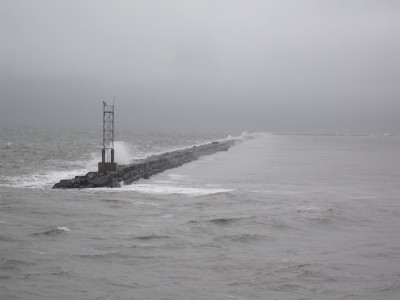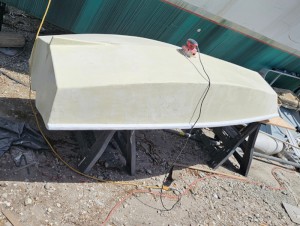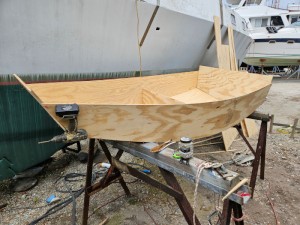Kaimusailing
s/v Kaimu Wharram Catamaran
| Vessel Name: | Kaimu |
| Vessel Make/Model: | Wharram Custom |
| Hailing Port: | Norwalk, CT |
| Crew: | Andy and the Kaimu Crew |
| About: | Sailors in the Baltimore, Annapolis, DC area. |
17 April 2024 | St Marys, GA
Dinghy Skeg
I was suffering with what seemed like a cold and also had allergy symptoms. I awoke and felt fine. The green pollen that was coating everything was gone. Maybe it will return.
07 April 2024 | St. Marys, GA
Clammy Hands
Items came in from TEMU, the Chinese cut rate retailer. One was a nice little drone that cost about twelve and a half dollars. It looked like an easy thing to play with while I coughed and sneezed. I was fighting a summer cold, even though it is not summer elsewhere, it seems like it here. A nice [...]
02 April 2024 | St. Marys, GA
Sun Doggie
After laminating the cedar strips onto the gunwales of the dinghy I found the screws I used wouldn’t come out. The epoxy had seized them. The screw heads were stripped so I cut a straight slot in the heads with the cut off wheel. The cedar smoked when the screw heads got red hot. I could remove [...]
21 March 2024 | St. Marys, GA
Just Add Water
The rainy weekend started off with overcast and fog but no rain. It looked like I might be able to get something done on the D4 dinghy. I wanted to change the bow seat which is really the bow deck. The sailing option uses the deck to hold the freestanding mast. I didn’t like how the deck looked, [...]
01 March 2024 | St. Marys, GA
D4 Dinghy Alternative Seats
The rain event was more wind than rain, strong winds with gusts up to 44 mph. We drove into town to see what the harbor was like. There was a small sailboat that had dragged anchor and was sitting close to shore. The tide was out. We left and played with Bleu at Notter’s Pond.
23 February 2024 | St. Marys, GA
D4 Inside Seams
Day two of the dinghy build started out with me finishing wiring the hull bottoms together on the centerline of the bottom panels. This was much easier than the wiring of the chine edges of the bottom panels and the side panels.
TS Karen, Go Away!

.
Any kind of self steering takes the place of a crew member. It's no replacement for someone on deck scanning the horizon, and it could let a crew slack off their duties and end up inattentive and have an embarrassing collision or grounding. Taking one task, a constant task, off of the crew's duties frees up time to take care of something else. It can help in an involved situation, helming the boat while a flapping sail is taken down.
.
It is a good idea to have a non-electrical system backing up a more sophisticated electronic system. There are many perils that can obliterate the electronics or electrics. Lightning, corrosion, dead batteries, or burnt circuit boards would make the Autohelm autopilot useless. Some yachts crash into Hilo Bay in Hawaii, reliably steered by their windvanes, with no one aboard, maybe one or two a year. It's a good idea to set your destination to one side of the intended landfall, in case you oversleep. It's also a good idea to use a jackline religiously, the same way a seatbelt in a car is used, because you never know.
.
The evolution of electronics progressed by constantly improving reliability and capacity of components, back in the old days. Then the evolution became a search for more features to sell to the customer and more sophistication and complication, computers, serial communication, networking instruments, touch screens, and on and on. Along this path, electronic circuits, and especially integrated circuits, have relied on thinner and shorter connections between components. That is how millions of components can be formed on a tiny integrated circuit. The older circuits have robust wiring. Some are MILSPEC, which is a stringent requirement for reliability for the armed forces. As long as weird voltage surges, lightning, static electricity, or ambient heat don't destroy the fine delicate sophisticated circuits, the modern electronics do wonderful things. Otherwise they can fail, their communication cables can fail, and out at sea, your voyage now has become more authentic. More like the old days of sextant, trailing log, dead reckoning, and the mechanical windvane.
.
Sailing is elemental and simple, except for all the things we do to make it more complicated and mysterious, or fearsome. In the old days they didn't have satellite phones, internet, wifi, or even television. The popular navigators gave talks and made a living writing books. We have to remember where this has all come from. Sailing is a way to sidle up close to nature and think we are somehow smart enough to outfox the elements. Then a bird flies by, gliding along perfectly, and we know we are copy cats.
.
Nature has a way of pleasuring us and fooling us until we start to notice the knees don't bend as well. Sailing is a physically demanding activity, and some aspects of it can be made easy with mechanical advantage. In the old days the old sailors would go out in a smaller boat with smaller sails. Another way is to have young crew to learn the craft and handle the physically demanding stuff. I like reading about what they did in the old days, and just finished a book by Miles Smeeton, "Because the Horn is There".
.
Smeeton was a successful writer, not only of nautical books, but of children's books. They don't seem to be available for kindle, but they come up online as used books and are well worth acquiring, and reading. He and his wife Beryl began their adventures not knowing much how to sail, but knowing a lot about adventuring. In their book, "Once is Enough", they recount their pitchpoling off Cape Horn, not once, but a second time after a complete refit in Chile. That they survived either disaster is remarkable. They then sailed a route that would make sense today, from the west Pacific north to Japan, the Aleutians, then down the North American west coast and on. It makes sense now because the Indian Ocean has been ruined by pirates in the east, near Malaysia, and in the west, off the African Coast.
.
After years of cruising, the Smeetons had a bone in their craw. Cape Horn. They were getting on in years and Cape Horn had defeated them and almost killed them and stood there defiant, daring them to come back to do battle. They left England and sailed south, closed the coast of South America and rounded the Horn. Smeeton gives plenty of references to the older days of the captains and sailors who named the islands, straits, headlands, and fought and died on the Patagonian shores. The Smeetons continued north and hit Hawaii and then to their new home in British Columbia. Next they sold their boat and moved ashore to a farm. They had done Cape Horn and finished a cruising lifetime.
.
Our forecast was for rain, remnants of a tropical storm. Great weather that had persisted for so long and had allowed so much good work to be done. Power tools were left out overnight because, "We will have dry weather for the next few days, how long can this persist?". Now we were heading into October, when last year a hurricane came through, just like the year before, and we can't complain about some rain. It would be nice to work on some more details on deck that require epoxy and warm weather to cure, but it's just as well to go below, finally, and continue on the interior.
.
I brought down a stockpile of pasta, sauce in jars, alcohol for the stove, and detergent for the sink. Let's go for an overnight trip. Maybe next week. Fall sailing is the best. The water, warmed from the summer, is slow to cool. Afternoons are pleasant, the leaves change. The summer crowds, mostly oblivious to sailing's illustrious old days, are gone back to work in the cities.
.
Another thank you for Sailomat manual is due Jason Cummings of Australia, who sent one along. The internet has made the cruising sailor community completely connected.
.
The rain arrived along with near gale winds. There was a reunion of Dottie the Safety Officer's family up the coast, north of Atlantic City, at Brigantine. We tracked the rain storm by driving along with it north, to the Lewes, Delaware, ferry which ran directly into the northeast 30 knots winds and driving rain.
.
The picture is of the Harbor of Refuge breakwater at Cape Henlopen, Delaware, at the mouth of Delaware Bay, near the ferry terminal.






